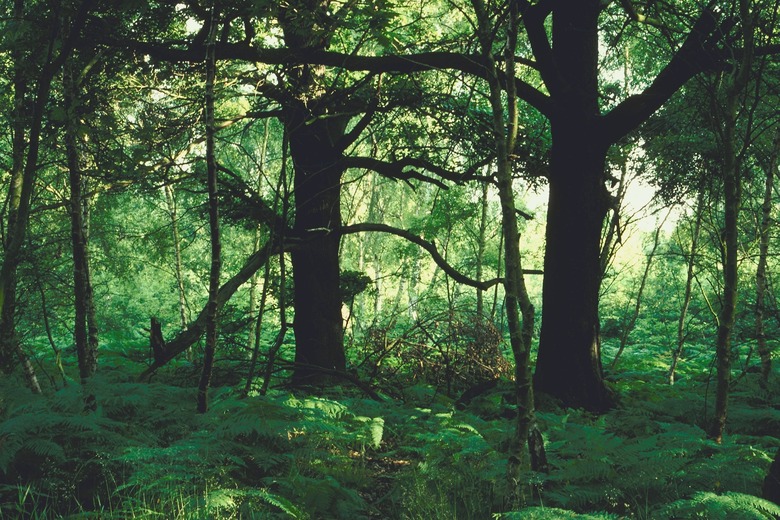Types Of Forest Ecosystems
Approximately 30 percent of the earth's surface is covered in all different types of forests, according to Elizabeth Mygatt, author of the article, "World's Forests Continue to Shrink." Mygatt goes on to further explain the crucial role that the forest ecosystem plays in maintaining a healthy planet, such as controlling the water cycle and stabilizing soils, assisting in leveling the climate by saturating and storing carbon dioxide, providing a habitat for wildlife and supplying wood, food and medicines. Across the world there are several different kinds of forests. The textbook definition of ecosystem, as stated in "Elemental Geosystems," is, "a self-regulating association of living plants, animals and their non-living physical and chemical environment."
Tropical Rain Forest Definition
Tropical Rain Forest Definition
In a tropical rainforest days usually last 12 hours, with temperatures averaging around 77 degrees F. A surplus of rain and high insolation (sunlight) are other year-round attributes of a tropical rainforest. Tropical rainforests cover the Amazon region, as well as equatorial regions in Africa, Southeast Asia, the east coast of Central America and elsewhere along the equator. These types of forest ecosystem are characterized by broadleaf evergreen trees, vines, tree ferns and palms.
Many tropical rainforests are known for their incredible biodiversity. Jungles like the Amazon are home to thousands of different types of species. Those include animals that crawl along the ground, like insects, lizards and rodents, as well as those that swing through the trees, like monkeys. Tropical rainforests also house vicious predators like anacondas and jaguars.
Tropical Seasonal Forest
Tropical Seasonal Forest
Located on the edges of rainforests are the tropical seasonal forests that receive dwindling and irregular rainfall. Some of the key parts of a forest in this zone are broadleaf evergreen trees, some deciduous trees and thorn trees. Deciduous trees lose their leaves during the winter.
Temperate Evergreen and Deciduous Forest Biome
Temperate Evergreen and Deciduous Forest Biome
Found in North America, Europe and Asia, temperate evergreen and deciduous forests tend to blend together at times. Needleleaf and broadleaf trees inhabit the forests. In southern and eastern areas that are fervent with evergreen pines, controlled forest fires still take place as the natural cycle of forest re-growth and enrichment.
They are called temperate forests because of their weather conditions. Compared to the extreme heat and humidity of a tropical rainforest, temperate evergreen and deciduous forests have moderate climates, with pleasantly warm summers and bearably chilly winters.
Boreal Forest
Boreal Forest
Boreal forests are home to many of the plants and animals typically thought of as forest-dwellers, such as:
- foxes
- moose
- reindeer
- bears
- squirrels
- wolves
Plants like fungi, mosses and lichen do well in the boreal climate, because they are tough enough to survive what can often be extremely cold, icy winters.
Savanna and Woodland
Savanna and Woodland
Savanna and woodland ecosystems have a susceptibility to fires and the ability to rejuvenate and re-grow. Prevalent in South America, Africa and Australia, savannas and woodlands are characterized by vast areas of grasslands, bush thickets and clusters of sparse trees with flattened crowns.
Because of pollution and deforestation, many types of forests around the world are in need of extra protection. It's important to remember how important a role forests play in the planet's ecosystem, and to do what you can in order to help the conservationists fighting to protect the plants and animals that live within the world's forests.
Cite This Article
MLA
Redfield, Shelby . "Types Of Forest Ecosystems" sciencing.com, https://www.sciencing.com/types-forest-ecosystems-5435605/. 12 October 2018.
APA
Redfield, Shelby . (2018, October 12). Types Of Forest Ecosystems. sciencing.com. Retrieved from https://www.sciencing.com/types-forest-ecosystems-5435605/
Chicago
Redfield, Shelby . Types Of Forest Ecosystems last modified August 30, 2022. https://www.sciencing.com/types-forest-ecosystems-5435605/
